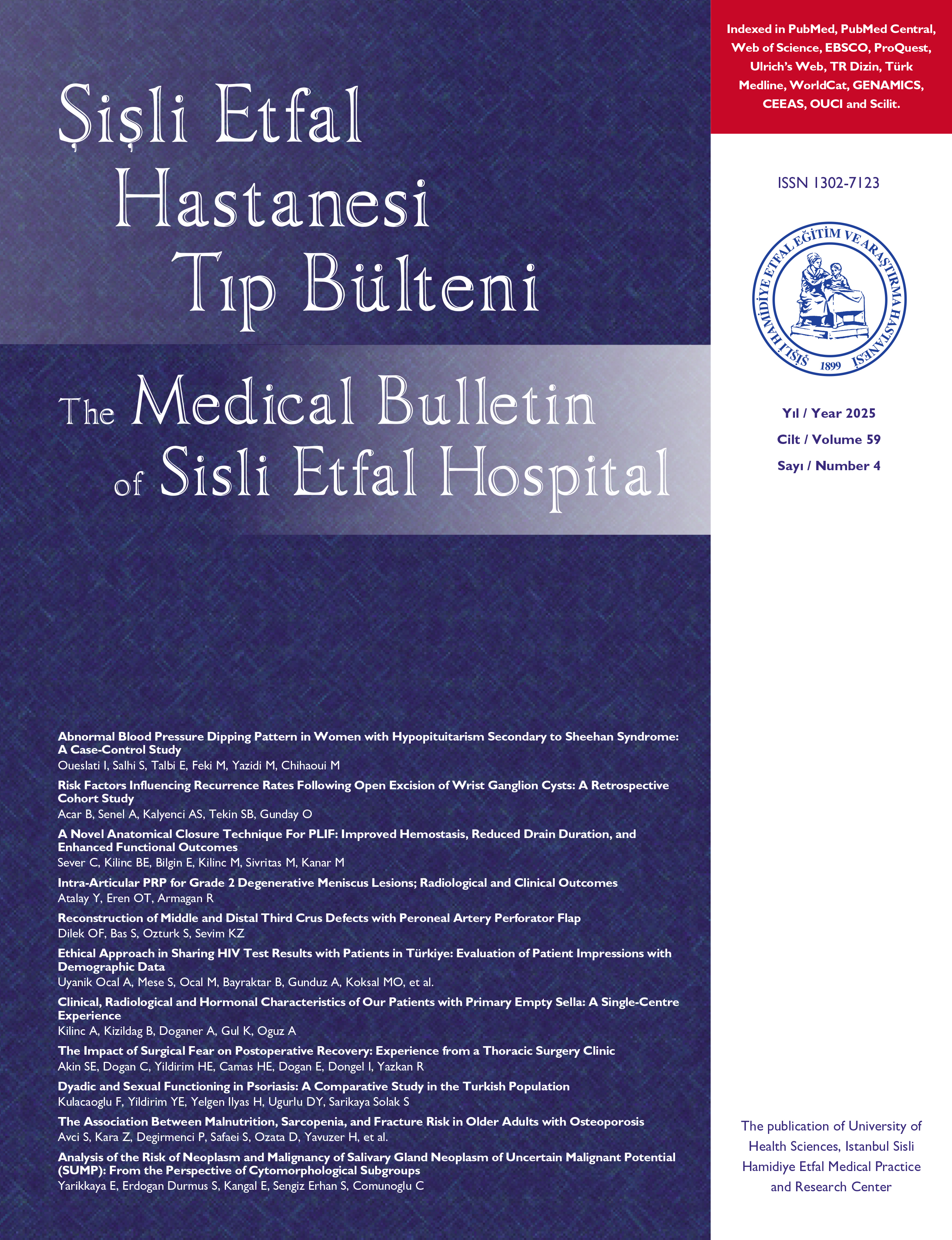
İnfantil Hipertrofik Pilor Stenozunda Laparoskopik Piloromiyotomi Deneyimlerimiz
Meltem Kaba, Cetin Ali Karadag, Mesut Demir, Nihat Sever, Aydin Unal, Melih Akın, Ali Ihsan DokucuŞişli Hamidiye Etfal Eğitim ve Araştırma Hastanesi Çocuk Cerrahisi Kliniği, İstanbulAmaç: İnfantil hipertrofik pilor stenozunun (İHPS) tedavisinde laparaskopik piloromiyotomi ameliyatındaki deneyimlerimiz doğrultusunda tekniğimizin gözden geçirilmesi ve sunulması amaçlanmıştır.
Gereç ve yöntem: Kliniğimizde Nisan 2016-Nisan 2018 tarihleri arasında laparaskopik piloromiyotomi uygulanan toplam 15 İHPSli olgunun kayıtları geriye dönük olarak incelendi. Olgular kullanılan laparaskopik teknikteki değişim, peroperatif ve postoperatif cerrahi komplikasyonlar açısından değerlendirildi.
Bulgular: Erkek-kız oranı 2.7: 1 olan hastaların başvuru yaşı 36.5 (25-110) gün idi. Tüm hastalarda fışkırır tarzda şiddetli safrasız kusma ve 8 olguda ise belirgin kilo alamama şikayeti saptandı. Hastaların bir tanesinin situs inversus totalis olması dışında ek tıbbi durum saptanmadı. Bir hastanın peroperatif olarak pilor stenozu olmadığı anlaşıldı. Bir hasta yetersiz piloromiyotomi tanısı ile tekrar opere edildi. Bir hastada peroperatif teknik zorluk nedeniyle açık ameliyata dönüldü. İlk laparaskopik piloromiyotomi vakasının ameliyat süresi 110 dakika iken serideki son ameliyatın süresi 35 dakika olarak kayıt edildi.
Sonuç: İnfantil hipertrofik pilor stenozu cerrahisinde laparaskopik yaklaşım, minimal invaziv cerrahiyi rutin uygulamakta olan cerrahlar için, hızlı bir öğrenme eğrisi ile iyi sonuçlara ve tatmin edici bir cerrahiye dönüşmektedir. (SETB-2018-07-097)
Anahtar Kelimeler: İnfantil hipertrofik pilor stenozu, laparoskopi; piloromiyotomi; minimal invaziv cerrahi.
Our Experience with Laparoscopic Pyloromyotomy in Patients with Infantile Hypertrophic Pyloric Stenosis
Meltem Kaba, Cetin Ali Karadag, Mesut Demir, Nihat Sever, Aydin Unal, Melih Akın, Ali Ihsan DokucuDepartment of Pediatric Surgery, University of Health Sciences Turkey, Sisli Hamidiye Etfal Training and Research Hospital, Istanbul, TurkeyObjectives: In this study, we aim to discuss our experience with laparoscopic pyloromyotomy in patients with infantile hypertrophic pyloric stenosis (IHPS) and skills development throughout our learning curve.
Methods: We retrospectively collected data from 15 patients with IHPS who underwent laparoscopic pyloromyotomy between 2016 and 2019 in our clinic. Evolution in operation techniques, peroperative and postoperative surgical complications were analysed.
Results: In this research, 15 patients (male-to-female ratio: 2.7/1) were studied. The median age at presentation was 36.5 days (25-100 days). Non-bilious projectile vomiting was seen in all of the patients, and in eight cases, marked failure to thrive was seen. Situs inversus totalis was seen in one of the cases as an associated anomaly, no other anomalies were noted. A palpable olive-shaped mass was found in only 33% of infants (five cases). A patient was detected to have no IHPS peroperatively. One of the cases was converted to open technique due to peroperative technical difficulties. A patient underwent 2nd operation due to incomplete pyloromyotomy. The duration of the first and last cases was 110 mins and 35 mins, respectively.
Conclusion: The laparoscopic approach in patients with infantile hypertrophic pyloric stenosis can result in good postoperative outcomes and satisfying surgery in the hands of surgeons who perform minimally invasive surgery routinely.
Keywords: Infantile hypertrophic pyloric stenosis, laparoscopy; minimal invasive surgery; pyloromyotomy.
Makale Dili: İngilizce



















